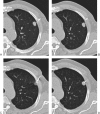Updates in percutaneous lung biopsy: new indications, techniques and controversies
- PMID: 24293806
- PMCID: PMC3577628
- DOI: 10.1055/s-0032-1330067
Updates in percutaneous lung biopsy: new indications, techniques and controversies
Abstract
The objective of percutaneous chest biopsy is to consistently reach the amount of tissue required to meet or exceed published diagnostic accuracy rates. Many recent publications have reevaluated the subject of chest biopsy to assess borderline or controversial indications such as very small lesions, ground-glass opacities, and cases with a past nondiagnostic percutaneous biopsy. In addition, publications have reviewed sample adequacy for the accurate determination of molecular markers. These new indications promise to expand the numbers of biopsy procedures performed by radiologists. This article discusses the current role of image-guided percutaneous lung biopsies in the management of patients with pulmonary malignancies.
Keywords: interventional radiology; lung malignancy; molecular markers; percutaneous biopsy.
Figures



References
-
- Boiselle P M, Shepard J A, Mark E J. et al.Routine addition of an automated biopsy device to fine-needle aspiration of the lung: a prospective assessment. AJR Am J Roentgenol. 1997;169(3):661–666. - PubMed
-
- Gong Y, Sneige N, Guo M, Hicks M E, Moran C A. Transthoracic fine-needle aspiration vs concurrent core needle biopsy in diagnosis of intrathoracic lesions: a retrospective comparison of diagnostic accuracy. Am J Clin Pathol. 2006;125(3):438–444. - PubMed
-
- Libby D M, Smith J P, Altorki N K, Pasmantier M W, Yankelevitz D, Henschke C I. Managing the small pulmonary nodule discovered by CT. Chest. 2004;125(4):1522–1529. - PubMed
-
- Jae L I June I H Miyeon Y Kwanseop L Yul L Hoon B S Percutaneous core needle biopsy for small (≤10 mm) lung nodules: accurate diagnosis and complication rates Diagn Interv Radiol 2012; June 5 (Epub ahead of print) - PubMed
-
- Bladt O, De Wever W. Additional value of CT-fluoroscopic biopsy of pulmonary lesions: a retrospective study of 69 patients. JBR-BTR. 2006;89(6):298–302. - PubMed
Publication types
LinkOut - more resources
Full Text Sources
Miscellaneous

